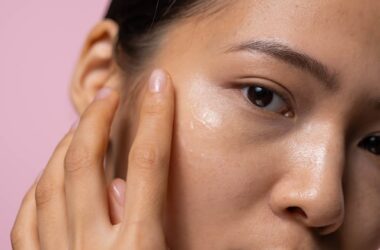Have you been wondering if you can use bakuchiol and hyaluronic acid together after researching about these two popular plant-based ingredients?
Worry no more. We’ve got you covered below.
Can You Use Bakuchiol and Hyaluronic Acid?
Yes, you can use both ingredients together—it’s a great combination for aging skin.
Hyaluronic acid is a well-known ingredient that has been used in skin care for years.
It’s a humectant, which means it draws moisture from the air and holds onto it in the skin.
Bakuchiol is a natural alternative to retinoids and has anti-inflammatory properties (which helps with redness and irritation) and vitamin C (which brightens the skin).
It’s important to be realistic about what you can expect from bakuchiol. Retinoids help make skin more resilient, so they make it less likely that you’ll get fine lines.
Bakuchiol isn’t as powerful as retinoids, but it also doesn’t have the same potential side effects, like skin flaking or peeling.
Bakuchiol is better for sensitive skin than retinoids, but both can be irritating when you first start using them.
If your skin doesn’t respond well to bakuchiol or retinoids, don’t give up on these ingredients—try an over-the-counter cream with hyaluronic acid instead.
What Is Bakuchiol?
Bakuchiol is a natural, plant-based alternative to retinol. It’s extracted from the seeds of the babchi plant. The antioxidant properties of bakuchiol help fight signs of aging while improving skin tone and elasticity.
How does bakuchiol work?
Bakuchiol works by increasing the production of collagen and elastic fibers while inhibiting the degradation of these fibers. This process results in skin that is more firm and less wrinkled. It also decreases fine lines and discoloration.
Can You Use the Same Serum for Both Bakuchiol and Hyaluronic Acid?
You can use the same batch of serum with both bakuchiol and hyaluronic acid, but it’s not quite that simple. You also have to consider how you’re adding the ingredients to your formula.
Step 1: Add Bakuchiol/Hyaluronic Acid to Oil Phase
Bakuchiol and hyaluronic acid are not water-soluble, so you can’t just add them directly to the water phase.
Bakuchiol is more soluble in oil than water, so adding it to the oil phase is preferred.
Hyaluronic acid is more soluble in water than oil, but it still solubilizes well in the oil phase (especially if you use a surfactant).
Step 2: Add Emulsifier
Once you’ve added your bakuchiol/hyaluronic acid to the oil phase, add an emulsifier (I prefer Cetearyl alcohol) to help integrate the two phases.
Step 3: Blend/Shake/Mix
Blend/shake/mix everything together vigorously to dissolve any undissolved bits of powder into solution.
Make sure you are thoroughly dispersing all ingredients into your solution before you proceed to the next step.
How Often Should You Use Bakuchiol and Hyaluronic Acid?
You’ll want to use bakuchiol and hyaluronic acid serums twice daily if you’re using them alone (without other serums or treatments).
If you’re using them with other products, you might want to choose just one product to apply to your face twice daily so that your skin doesn’t get overwhelmed by too many active ingredients at once.
What Other Products Work With Bakuchiol and Hyaluronic Acid?
Bakuchiol and hyaluronic acid are natural ingredients that can help fight wrinkles.
However, you should use them together with other ingredients to maximize their effectiveness.
1. Sodium Hyaluronate
2. Methylpropanediol
3. Glycerin
4. Dimethyl Sulfone
5. Allantoin
6. Phenoxyethanol
7. Carbomer
8. Ethoxydiglycol
9. Sodium Hydroxide (Sodium Hydrate)
10. Xanthan Gum
Do You Need to Take a Break From Bakuchiol and Hyaluronic Acid From Time to Time?
Bakuchiol and hyaluronic acid are both natural ingredients, so they won’t harm your skin. However, it’s still a good idea to take a break from them every once in a while.
You should also keep track of any negative side effects you experience and see a dermatologist if you experience severe irritation or breakouts while using these products.
When Can You See Results From Using Bakuchiol and Hyaluronic Acid?
Most people begin to notice results within a month of using Bakuchiol and Hyaluronic Acid products on a regular basis.
Bakuchiol has been shown to be effective for reducing the look of fine lines, wrinkles, crow’s feet, age spots, and other types of sun damage.
It does this by stimulating collagen production and providing anti-inflammatory benefits.
Hyaluronic Acid works with Bakuchiol by helping your skin hold onto moisture better so it looks more supple and healthy.
Can You Use Bakuchiol and Hyaluronic Acid While Pregnant?
Bakuchiol and hyaluronic acid are natural skin-care ingredients that can be used during pregnancy with no side effects.
Whether or not it’s safe to use these ingredients while pregnant, however, depends on which active ingredient you’re talking about and in what type of formulation.
Bakuchiol is a plant-derived alternative to retinol that is often used as an antioxidant and anti-aging ingredient in skincare products.
Some evidence suggests that bakuchiol may be effective at fighting signs of aging on the skin, but studies have also shown that bakuchiol may be harmful to the developing fetus when taken orally during pregnancy.
The safety of topical applications of bakuchiol has not been extensively studied.
However, there does not appear to be any reason to believe that topical applications would be harmful for a pregnant woman or her developing baby.
Hyaluronic acid, on the other hand, is a naturally occurring substance found throughout the body.
It plays a key role in keeping skin healthy and also occurs naturally in the breast milk of breastfeeding women.
Hyaluronic acid is often used in topical anti-aging formulations because it helps to keep skin soft and hydrated.
Do You Have to Discontinue Any Other Products Before Using Bakuchiol and Hyaluronic Acid?
You do not need to stop using your other products before trying Bakuchiol and Hyaluronic Acid. All you need is a small amount of the serum, massaged into the skin twice daily.
As long as you have healthy skin, there should be no problem with adding this product to your regimen.
Is Bakuchiol and Hyaluronic Acid Good for Dark Circles Under Eyes?
Bakuchiol and hyaluronic acid both have similar properties when it comes to improving skin health. They can both help keep your skin hydrated, smooth out wrinkles, and reduce under-eye dark circles.
Which Is Better: Hyaluronic Acid or Bakuchiol?
Hyaluronic acid and bakuchiol are two plant-based ingredients that serve the same purpose- hydrating the skin.
Both are also frequently used in anti-aging products due to their ability to replenish moisture and restore elasticity to the skin. However, each ingredient has its own set of pros and cons, making it difficult to choose a clear winner.
Taken at face value, both ingredients appear to be equally effective at moisturizing the skin.
In fact, when you compare the two side by side, they have very similar properties.
So why would someone want to opt for one over the other?
The answer lies in what they’re made of and how they’re extracted from their respective plants.
Hyaluronic acid is a naturally occurring substance found in many living organisms.
It acts as a cushion for joints and muscles, offering protection and flexibility as we move around during the day.
This property also applies to our skin’s surface; as we age, our epidermis loses its ability to retain water molecules effectively, leading to dryness and wrinkles.
Are There Any Side Effects of Using Bakuchiol and Hyaluronic Acid?
Bakuchiol is an antioxidant chemical compound extracted from the seeds of babchi. It’s very effective in reducing the signs of aging and is extremely safe to use.
So no, there are no side effects associated with using bakuchiol and hyaluronic acid together.
But if you’re new to using skincare products, you should start by using only one of these ingredients at a time so that you can track and monitor any changes in your skin.
How to Use Bakuchiol and Hyaluronic Acid in the Morning
Here are six tips to help you get the most out of bakuchiol and hyaluronic acid;
1. Use a serum that includes both bakuchiol and hyaluronic acid in addition to other potent antioxidants like Vitamin E. Try Juice Beauty Green Apple Antioxidant Serum or EltaMD AM Therapy Facial Moisturizer SPF 30.
2. Layer your products with a lightweight moisturizer such as SkinCeuticals Hydrating B5 Gel or any oil-free moisturizer.
3. Apply your makeup after you’ve applied your skincare products so you can fully reap the benefits of these amazing ingredients.
4. Dilute bakuchiol or hyaluronic acid in water first, then apply with a spray bottle. Bakuchiol will also dissolve in alcohol, which may make it easier to mix with other products.
5. Add these ingredients to homemade skincare products such as exfoliators, masks, and toners. You can even add them to natural cooking oil for a homemade body scrub.
6. Use them in sheet masks for an extra boost of hydration during your weekly facial routine.
7. Get creative! These are just a few suggestions, but you can also add bakuchiol and hyaluronic acid to homemade lip balm, hair products, and more!
Final Thoughts
The takeaway here is that while bakuchiol and hyaluronic acid are both plant-based compounds, they work in different ways.
Bakuchiol is more of an antioxidant, whereas hyaluronic acid offers anti-inflammatory properties.
Either of these can be used on their own or combined with one another, as well as other actives in your skincare routine.







